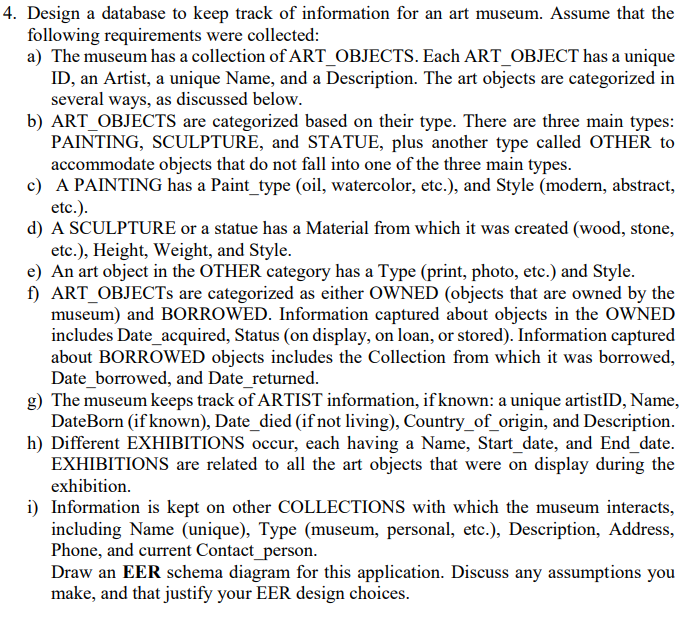Design a Database to Keep Track of Information for an Art Museum

(Solved) : four Design Database Go along Track Information Art Museum Assume Following Requirements Collecte Q39672659 . . .
$half dozen.00

iv. Design a database to proceed track of information for an art museum. Assume that the post-obit requirements were nerveless: a) The museum has a collection of ART_OBJECTS. Each ART_OBJECT has a unique ID, an Artist, a unique Proper noun, and a Description. The art objects are categorized in several ways, as discussed beneath. b) ART OBJECTS are categorized based on their blazon. There are three main types: PAINTING, SCULPTURE, and STATUE, plus some other type called OTHER to accommodate objects that do not fall into one of the iii main types. c) A PAINTING has a Paint type (oil, watercolor, etc.), and Fashion (modern, abstract, etc.). d) A SCULPTURE or a statue has a Material from which it was created (wood, stone, etc.), Superlative, Weight, and Manner. e) An art object in the OTHER category has a Type (print, photograph, etc.) and Mode. f) Art OBJECTS are categorized as either Owned (objects that are owned by the museum and BORROWED. Data captured about objects in the Endemic includes Date_acquired, Status (on display, on loan, or stored). Information captured about BORROWED objects includes the Collection from which it was borrowed, Date_borrowed, and Date_returned. 1000) The museum keeps track of ARTIST information, if known: a unique artistID, Name, DateBorn (if known), Engagement died (if not living), State of origin, and Clarification. h) Unlike EXHIBITIONS occur, each having a Proper name, Start_date, and End appointment. EXHIBITIONS are related to all the art objects that were on display during the exhibition. i) Information is kept on other COLLECTIONS with which the museum interacts, including Name (unique), Type (museum, personal, etc.), Description, Address, Phone, and electric current Contact person. Draw an EER schema diagram for this application. Discuss whatsoever assumptions you brand, and that justify your EER blueprint choices. Show transcribed prototype text 4. Design a database to go along runway of information for an art museum. Assume that the following requirements were collected: a) The museum has a collection of ART_OBJECTS. Each ART_OBJECT has a unique ID, an Artist, a unique Proper noun, and a Description. The art objects are categorized in several ways, every bit discussed beneath. b) ART OBJECTS are categorized based on their type. There are three chief types: PAINTING, SCULPTURE, and STATUE, plus another type chosen OTHER to adapt objects that do non fall into one of the three main types. c) A PAINTING has a Paint type (oil, watercolor, etc.), and Style (modern, abstract, etc.). d) A SCULPTURE or a statue has a Cloth from which it was created (woods, rock, etc.), Tiptop, Weight, and Manner. e) An art object in the OTHER category has a Type (impress, photo, etc.) and Style. f) Art OBJECTS are categorized equally either OWNED (objects that are owned by the museum and BORROWED. Information captured about objects in the Endemic includes Date_acquired, Status (on display, on loan, or stored). Information captured nigh BORROWED objects includes the Drove from which it was borrowed, Date_borrowed, and Date_returned. g) The museum keeps track of Artist information, if known: a unique artistID, Proper noun, DateBorn (if known), Appointment died (if not living), Land of origin, and Clarification. h) Different EXHIBITIONS occur, each having a Proper noun, Start_date, and Terminate date. EXHIBITIONS are related to all the fine art objects that were on display during the exhibition. i) Data is kept on other COLLECTIONS with which the museum interacts, including Name (unique), Type (museum, personal, etc.), Description, Accost, Phone, and current Contact person. Draw an EER schema diagram for this application. Discuss whatever assumptions you make, and that justify your EER design choices.
Expert Respond
Answer to iv. Design a database to continue track of information for an art museum. Assume that the following requirements were collect…
- Description
Description

four. Design a database to proceed rails of information for an art museum. Assume that the post-obit requirements were collected: a) The museum has a collection of ART_OBJECTS. Each ART_OBJECT has a unique ID, an Creative person, a unique Proper noun, and a Clarification. The art objects are categorized in several ways, equally discussed below. b) ... View full description
Source: https://www.coursehigh.com/product/solved-4-design-database-keep-track-information-art-museum-assume-following-requirements-collecte-q39672659/

0 Response to "Design a Database to Keep Track of Information for an Art Museum"
Post a Comment